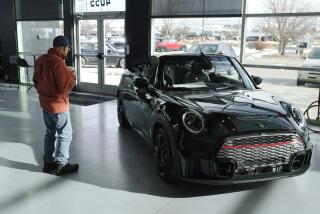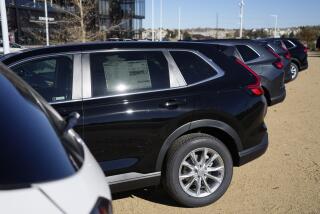More U.S. buyers are big on small SUVs, cars
- Share via
Once shunned by automakers trying to make a go of it in the super-sized American market, small cars are catching on again.
They’re not going to solve the industry’s myriad problems: The 41 car models and eight compact sport utility vehicles that make up the segment account for fewer than 20% of total annual passenger vehicle sales.
And profits -- if any -- from small cars are typically much lower than those from large cars and trucks.
But as U.S. gasoline prices remain stubbornly stuck near the $3-a-gallon mark, small cars and SUVs have been the auto industry’s only bright spot.
Even as the overall market fell 2.9% during the first four months of 2007 compared with the year-earlier period, sales of small cars rose 0.2% and small SUVs gained 38.6%.
Dodge has its Hemi, Ford its F-150 pickup and Toyota its Prius hybrid, but it’s the Mazda3, an upscale compact with sporty European styling, that stands out as one of the hottest cars in the industry.
Augmenting the Mazda3’s widely praised good looks, taut handling and long list of standard and optional features are a price tag that starts near $14,000 and a fuel economy rating of 25 miles per gallon in the city and 34 mpg on the highway.
Although Mazda Motor Corp. introduced Mazda3 in late 2001 and the car should be on its last legs before a major redesign, sales rose nearly 30% for the first four months this year after a 22% gain in 2006.
Whether shopping for a Mazda3 or a full-size Buick Lucerne sedan, “Americans are still concerned about bang for the buck,” said Alex Rosten, an industry analyst for online automotive information provider Edmunds.com in Santa Monica.
That’s what drew Bay Area resident Gerthy Vasquez to her local Mitsubishi dealer and its display of 2008 Lancer compacts this week. Vasquez, 28, said she was attracted to the $22,000 Lancer she purchased because of its mileage rating, a key concern given that she commutes 250 miles a week between her home in Vacaville and her job as a bank loan officer in Concord.
“But what I really love is that it’s roomier and sportier than the old Lancer,” said Vasquez, a single mother of two. “I didn’t want a car that made me look like I had two kids in the back seat, although it’s great that it’s big enough to get them both back there.”
Today’s small cars “are not the stripped-down models of 30 years ago,” Edmunds.com’s Rosten said.
Most small cars and SUVs these days offer as standard or optional equipment features such as air conditioning, power windows and door locks, traction control, side-curtain air bags, four- and six-speaker stereo systems with multi-disc CD players and iPod connectivity, navigation systems, power sunroofs and leather seats.
“People are looking much more closely at small cars, but they still want them to be interesting,” said George Peterson, president of market research firm AutoPacific Inc. in Tustin.
As automakers redesign their small cars, they have found ways to make them roomier than predecessor models -- for example, by using transverse, or sideways-mounted, engines.
Combine added features and size with decent gasoline mileage, and it is easy to understand why small-car sales last year rose by more than three times the overall industry gain of 1.5%. Sales of small SUVs rose 36% even as all truck sales dropped almost 6%.
The reasons for buying are as varied as the buyers and have always included fuel economy. But until recently that concern was far down the list, Peterson said. Now, it has become a big factor in the market shift.
On one side, the government’s demand for better overall fuel economy is driving many automakers to add small cars to their fleets to offset the gas-gulping large trucks and big cars with V-8 engines that make up most of their sales, said Eric Noble, president of CarLab, an automotive research and product planning consultancy in Orange.
And on the customer side, “gas prices, then features and size,” are driving buying decisions for many, Rosten said.
Even buyers such as 17-year-old Sean Galvin -- limited to small cars by budget and a preference for something that at least looks fast and furious -- say fuel economy is a factor.
Galvin, who traded in a secondhand 1999 Honda Civic on Friday for a 2008 Lancer, says he also considered a compact pickup truck because about half of his friends at Kennedy High School in La Palma drive them.
“But sedans are easier to drive,” he said, “and they are cheaper on gas.”
Galvin earned part of the down payment for his $19,500 new car from a job at a local Dairy Queen and borrowed the rest from his parents.
And although Galvin drives only about 40 miles a week, he said, “fuel economy is important.”






